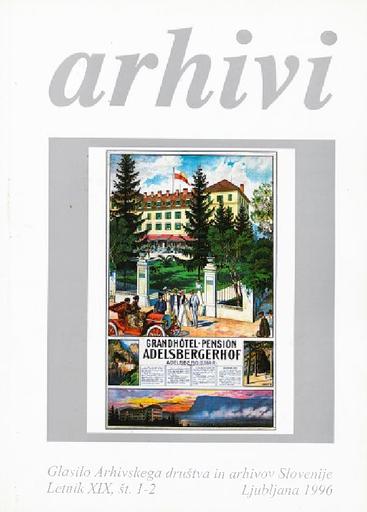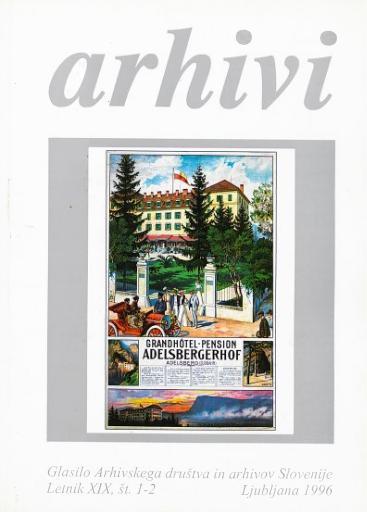/
Periodicals
/
Archives
The Administrative Divisions in the Slovene Part of Yugoslavia Between 1929 and 1941

Author(s):Miroslav Stiplovšek
Co-author(s):Matevž Košir (ur.)
Year:1996
Publisher(s):Arhivsko društvo Slovenije, Ljubljana
Source(s):Arhivi, 1996, št. 1-2
Language(s):slovenščina
Type(s) of material:text
Keywords:med obema vojnama, Kraljevina SHS, državna ureditev, državna uprava, administrative sivisions, Yugoslavia, Slovenia, 1929-1941
Rights:

This work by Miroslav Stiplovšek is licensed under Creative Commons Attribution-NonCommercial-NoDerivs 4.0 International
Files (1)

Name:Arhivi_1996_1-2.pdf
Size:12.59MB
Format:application/pdf
Permanent link:https://hdl.handle.net/11686/file2692
Description
In his article, the author deals with the characteristics of the administrative divisions in
Slovenia, when it was a part of the first Yugoslav state, during the period from 1929.
(when the king established his dictatorship), up until April 1941, when the war broke
out. As the author stales, all levels of authority underwent considerable changes at that
time. Together with the renaming of the country into the Kingdom of Yugoslavia, the
country was also divided into new administrative units - the banovinas. and the
Slovene part of Yugoslavia incorporated into the Dravska Banovina. In 1929. the
jurisdiction and organisation of the Ban's Office and lower authorities were defined for
the next ten years to come, and with the new legislature in 1933/34, the same manner
of organisation also came into force for the rural and urban municipalities. This was
followed by the merging of properties on a municipal level. The constitution imposed
by the king in 1931 renewed a parliamentary system which was more of a sham than a
democracy, and the constitutional decrees on the autonomy of the banovinas were
never implemented. Therefore, during the entire time of its existence, the Ban's
Council of the Dravska Banovina (1931-1941) was merely an advisory agency of the
ban. Despite these limitations, however, it strived to extend its powers and to
contribute to the social, economic, cultural and educational development of Slovenia.
Metadata (12)
- identifierhttps://hdl.handle.net/11686/10321
- title
- Državne ureditve na jugoslovanskem ozemlju Slovenije 1929-1941
- The Administrative Divisions in the Slovene Part of Yugoslavia Between 1929 and 1941
- creator
- Miroslav Stiplovšek
- contributor
- Matevž Košir (ur.)
- subject
- med obema vojnama
- Kraljevina SHS
- državna ureditev
- državna uprava
- administrative sivisions
- Yugoslavia
- Slovenia
- 1929-1941
- description
- In his article, the author deals with the characteristics of the administrative divisions in Slovenia, when it was a part of the first Yugoslav state, during the period from 1929. (when the king established his dictatorship), up until April 1941, when the war broke out. As the author stales, all levels of authority underwent considerable changes at that time. Together with the renaming of the country into the Kingdom of Yugoslavia, the country was also divided into new administrative units - the banovinas. and the Slovene part of Yugoslavia incorporated into the Dravska Banovina. In 1929. the jurisdiction and organisation of the Ban's Office and lower authorities were defined for the next ten years to come, and with the new legislature in 1933/34, the same manner of organisation also came into force for the rural and urban municipalities. This was followed by the merging of properties on a municipal level. The constitution imposed by the king in 1931 renewed a parliamentary system which was more of a sham than a democracy, and the constitutional decrees on the autonomy of the banovinas were never implemented. Therefore, during the entire time of its existence, the Ban's Council of the Dravska Banovina (1931-1941) was merely an advisory agency of the ban. Despite these limitations, however, it strived to extend its powers and to contribute to the social, economic, cultural and educational development of Slovenia.
- Avtor v razpravi nadaljuje osvetlitev značilnosti državnih ureditev na Slovenskem v prvi jugoslovanski državi za obdobje od uvedbe diktature 1929 do aprilske vojne leta 1941 in ugotavlja, da so tedaj doživele spremembe vse ravni oblasti. Hkrati s preimenovanjem države v Kraljevino Jugoslavijo je bila država razdeljena na nove upravne enote - banovine, jugoslovanski del Slovenije pa vključen v Dravsko banovino. Že leta 1929 so bile za vsa trideseta leta določene pristojnosti in tudi organiziranost banske uprave in sreskih načelslev. z zakonodajo 1933/34 pa je bil ta problem urejen še za podeželske in mestne občine, posledica pa je bila njihova obsežna komasacija. Oktroirana ustava leta 1931 je obnovila bolj navidezen kot dejanski parlamentarizem, njena določila o uvedbi banovinskih samouprav pa nato niso bila izvedena. Banski svet Dravske banovine (1931-1941) je tako ves čas ostal le banov posvetovalni organ, v praktični dejavnosti pa si je prizadeval povečati pristojnosti in dati čimvečji prispevek k socialnoekonomskemu in kulturnoprosvetnemu napredku Slovenije.
- publisher
- Arhivsko društvo Slovenije
- date
- 1996
- type
- besedilo
- language
- Slovenščina
- isPartOf
- rights
- license: ccByNcNd
Citirano v (1)
| Tipologija | Avtor(ji) | Naslov | Kraj | Založba | Leto |
|---|---|---|---|---|---|
| 2.01 Znanstvena monografija | Perovšek, Jurij | Slovenci in slovanski svet : politične slike od včeraj in danes | Ljubljana | Inštitut za novejšo zgodovino | 2019 |
